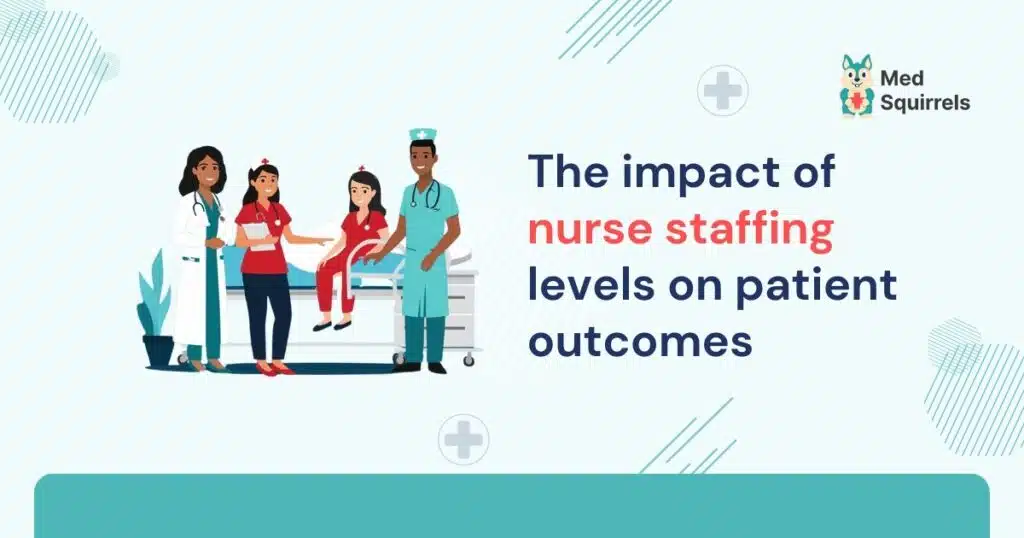The impact of nurse staffing levels on patient outcomes

According to the latest reports by the American Hospital Association, hospitals have started witnessing financial issues due to rising labor costs. The understaffing of nurses tends to create a severe impact on the healthcare system, affecting nurse staffing and patient outcomes.
Labor costs increased between 2021 and 2023 by $42.5 billion, and thus, hospitals are caught between a rock and a hard place fighting rising costs. Drug shortages and administrative burdens are creating more pressure on the healthcare department.
Changes in food consumption, climatic alterations, and changes in physical health alongside the post-COVID-19 effect have impacted the census numbers, and at times, the hospitals become overcrowded. In addition to all these, hospitals are facing tremendous challenges due to nurse staffing and increased prices of drugs.
Understaffing has created an adverse effect on healthcare departments. It is the tie that binds and creates issues that impact both patients and nurses at the same time.
In this blog, we will cover the various issues arising from understaffing, focusing on what patient outcomes are negatively impacted by nursing staff reduction. We will also explore smart nurse staffing and its potential to alleviate these challenges.
Following are some issues that may arise due to understaffing
Understaffing impacts patient care
With limited nurse staffing, it is impossible to provide supportive care to patients while also handling multiple tasks. Low and close monitoring of patient safety may increase medical complications, treatment errors, and chances of infections, creating a negative effect on patient care nurse staffing and patient outcomes.
Understaffing creates burnout and stress
Heavy workloads and limited resources tend to create burnout and stress for nurses, and this directly impacts patient care. Increased pressure and burnout may also impact both the nurses and patients. Understanding what patient outcomes are negatively impacted by nursing staff reduction is crucial to addressing these challenges.
Understaffing impacts the hospital’s reputation
Understaffing directly impacts patient care, compromising patients’ trust in the hospital. Dissatisfied patients with inadequate care and no proper communication with nurses are more likely to leave a negative impression on the hospital, directly impacting the hospital’s reputation.
Understaffing is a loop, and the cycle continues. With limited staff, burnout and stress for nurses would increase, creating a negative impact on patient care. Low patient outcomes would impact the hospital’s reputation, and this cycle would continue.
But what if you undertake a proactive strategy to hire nurses considering the patient outcomes? The results may vary with smart nurse staffing.
Nurse staffing is correlated to patient care and mortality rates, impacting nurse staffing and patient outcomes
At present, the census rate is relatively high. The increasing census rate tends to have a huge impact on mortality rates. This is an evident and inevitable situation. It is crucial to understand what patient outcomes are negatively impacted by nursing staff reduction.
In these cases, a higher nurse staffing rate would play a vital role in providing the proper patient care. Adequate staffing would improve regular monitoring of medical analysis. With enough nurses on the floor, there will be no room for medical errors and complications, exemplifying smart nurse staffing.
As per the reports of the Journal of the American Medical Association, hospitals with more nurses on the floor have a low count of census rate as well as mortality rate.
Given below are the top two reasons why hospitals should engage an adequate number of nurses for improved patient care and outcomes.
Enhanced patient experience and satisfaction
Adequate nurse staffing not only ensures a low mortality rate but also increases patient recovery rates. Patient recovery from a critical disease would require personal care and regular monitoring. With adequate nurses reporting on the floor, patient recovery increases as they get the desired personal care.
Furthermore, nurses can maintain communication with the patients, talking about their medical complications and concerns. This communication directly creates a positive impact on overall patient satisfaction and experience. Patient recovery acts as a critical indicator for any healthcare facility and promotes trust.
Adequate nurse staffing improves the productivity level of nurses
In unanticipated situations, when the patient counts along with the mortality increases, it creates pressure on the healthcare workforce, leading to increased burnout. Such situations mainly result from understaffing and create dissatisfaction in the job for the existing workforce.
Thus, adequate staffing equips patients with better communication which helps in addressing their medical issues and getting the desired compassion during their stay at hospitals. It also helps in improving the productivity levels of the healthcare workforce, reducing burnout and job dissatisfaction.
The period between 2020-2023 has been a rough road for hospitals. The increased disease rate, the COVID-19 impact, and the climatic changes are making significant impacts on hospitals. The understaffing of nurses is threatening such a scenario.
Here are some smart steps to do the right balance
Invest more in hiring
One of the smart ways to save healthcare costs and improve patient care is to invest in nurse hiring. With more nurses on the floor, managing and improving nurse staffing and patient outcomes is easy. As stated before, improved patient outcomes play a huge role in the hospital’s reputation.
Work on smart strategies for hire and retention
Nurse staffing is not rocket science, but one mistake can create significant consequences. In order to avoid this, clear strategies should be implemented by standardizing the number of nurses to the number of patients. It is mandatory to ensure that minimum staff levels are met in all healthcare facilities. Understanding what patient outcomes are negatively impacted by nursing staff reduction is crucial to formulating these strategies.
It is equally important to retain the existing nurses as they are already aware of and trained in the operations and procedures of the healthcare facility. Employers must retain them by offering competitive salaries, benefits, and appreciation in order to tackle burnout.
Exploring cutting-edge technologies
Utilizing the latest technologies would help in addressing the barriers to nurse staffing. With the healthcare AI tools, it is easy to assess the number of nurses required according to the patient count. This process would help meet staffing levels accordingly and optimize resource allocation. Also, real-time tracking tools can be used for determining nurse workload and patient acuity fluctuations. Such tools can automatically create a report if dynamic staffing is required, exemplifying smart nurse staffing.
Balancing nurse staffing levels is not a child’s play. It requires regular monitoring of the staffing market, adaptation of the latest technologies, and proper management of human resources. It is a time-consuming and expensive process.
Worried about maintaining the right balance in nurse staffing levels? Let MedSquirrels take the challenge
Now you can get the right staffing solution by collaborating with MedSquirrels. As one of the leading healthcare staffing platforms in the United States, we possess a vast and versatile pool of staffing talent for both clinical and non-clinical departments. We follow a proactive strategy and a streamlined process to get you connected with the top talent for your contract and permanent requirements.
Our platform automates the entire interview process, ensuring that the potential candidate is provided on time without any surprising delays. As an employer of record, we guarantee zero tolerance for legal non-compliance and risks. Hiring with MedSquirrels is way more affordable than many nurse staffing agencies. We don’t charge like the usual agencies and follow a subscription model. You only need to pay payroll costs and a flat fee per hire without any hidden agency charges such as MSP or VMS fees.
Ready to see how Medsquirrels work? Book a demo today!
FAQs.
How does nurse staffing influence patient outcomes?
Nurse staffing and patient outcomes are much interdependent; adequate levels of staffing can determine the quality of patient care and better health outcomes.
What are the patient outcomes that suffer in case of a reduction in nursing staff?
Reduced nurse staffing can negatively affect patient outcomes, including the higher incidence of hospital-acquired infections, increased length of stay in the hospital, and mortality rates.
What are the benefits of smart nurse staffing?
In today’s modern world, smart nurse staffing plays a vital role and it ensures the right number of qualified nurses are available to meet patient needs, improving overall patient care and satisfaction.
Why is nurse staffing important for patient safety?
Proper nurse staffing levels are essential for patient safety, as they help prevent medical errors, reduce complications, and ensure timely care.
How can health facilities improve nurse staffing and patient outcomes?
Healthcare facilities can improve nurse staffing and patient outcomes by using data-driven approaches and intelligent nurse staffing solutions to maximize staffing levels and patient care.
Jani Basha is a healthcare staffing expert at MedSquirrels, writing insights on staffing trends, hiring best practices, and career growth for healthcare professionals.
